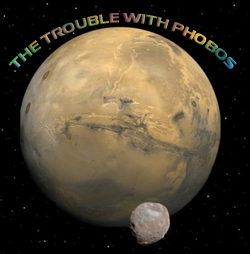

By Harv Howard ©2010
We have been lead to believe that our efforts into space have advanced along purely typical lines of scientific investigation of natural phenomena such as Mankind has always done on Earth. That quest has naturally moved outward to other worlds in our solar system and beyond as technology has allowed. Such is true in the greater sense of what Science is about. But the driving force of off-planet investigations has at its core a hidden agenda beyond that of our innate curiosity. The directed goal has been a search for answers to a troubling predicament: Where do the UFO's come from, and are they local to our solar system?
We are in the midst of a slow, scientific disclosure that started with our early space probes and is increasing in velocity at an ever-increasing rate. Under our watchful and frequently enthralled eyes we have been presented with a growing escalation of new discoveries every few weeks. The public knows these revelations as Martian meteorites with fossilized primitive life forms, water on Mars, and the Moon, Titian maybe harboring life in its oceans, Mars anomalies, and, recently, planets found around other stars. Without a doubt, the discovery of earth-like planets will be found any day now. Closer to home and in recent weeks, there has been a recent renewing of the argument over the results from the Viking “search for life” experiments in the late 1970s. Unbeknown to the public, that all-important question has never been fully or correctly answered.
What has never been discussed to any firm conclusion or even headed in the right direction is an important key that could have answered the question of life on Mars early on in our investigations of the planet. That finding was not about primitive life forms, but evidence of intelligent actions. But that surprise discovery was successfully kept hidden in plain sight with a very low level of interest shown in the data. (If that sounds like an incredible assertion, consider how the reality of UFOs have been kept from the public for over half a century.)
Being the giver of all data in the early years of space exploration, NASA has kept the lid on the secret, but times have changed. NASA (the US government) no longer has total control. It has partners and competitors with which to work and contend. The single-handed, iron-fisted control of data by NASA (and Malin) is gone. Politics and ideologies enter the picture of what we find out there and how to interpret and report it. Strangely enough or not, even our non-NASA, pro-ETs and pro-UFOs organizations, prominent writers in the field, and self-promoting showmen have not responded to the key data that resides in the public domain, dormant, virtually hidden from easy access. Perhaps it would be more correct to say there exists in some of these areas a “hands-off” policy coupled with overt attempts to focus attention elsewhere because this knowledge does explicitly explain straight away by implication the UFO phenomena.
First, we need to understand the evolution of the situation from the beginning to where it is now, crowded with more participants. Briefly, as the 1960s’ development of ICBMs grew to monstrous proportions, they were soon topped with smaller rockets to give an extended reach to orbital flight and eventually to missions to the planets. The simple charts we see of the numerous planetary launches, both successes and failures, by the Soviets and the US belie the course of events and the jockeying of the super-powers. Critical decisions were made. The Soviets chose Venus to explore as being the home of the ETs, and NASA aimed for Mars. Both nations dabbled somewhat in the territory of the other, but to no great success. It didn’t take much probing from the Soviets to prove Venus inhospitable. Strangely or not, their attempts to study Mars were almost totally disastrous. The NASA/JPL scientists joked that a Martian monster reached out and thwarted in some fashion about every Soviet effort thrown toward that planet. The Soviets had over thirty failed shots to Mars, one after another. Whatever the real reason, the Soviets were shut out on Mars despite their successes to Venus. On the other hand, almost all of NASA’s missions to Mars were successes. (And we have reason to doubt some reported failures!)
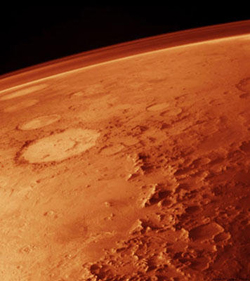 Mars,
via the progressive discoveries of Mariners 6, 7 and finally, 9 in 1971, turned
out to be the likely source for ETs in this solar system. True, it was indeed an
alien environment as compared to Earth, but it was considered to be the last
possible planet in the solar system that had even a minute chance of supporting
(or having supported) some aspect of life.
Mars,
via the progressive discoveries of Mariners 6, 7 and finally, 9 in 1971, turned
out to be the likely source for ETs in this solar system. True, it was indeed an
alien environment as compared to Earth, but it was considered to be the last
possible planet in the solar system that had even a minute chance of supporting
(or having supported) some aspect of life.
At Carl Sagan’s urging, who sincerely believed life existed on Mars, mysterious Phobos was added to the Mariner 9 flight program. About 70 images of Phobos were returned. The quality of the images was not sterling, but enough data was recovered to show unsettling anomalies that piqued interest. In addition, the moon was not ball-shaped like a moon is usually considered, but it was similar to a chunk of rock, possibly a captured asteroid. From then on Phobos, itself, was high on the agenda for data acquisition in future Mars’ explorations although Mars itself remained the prime focus.
The Viking program began in 1968 and development started in 1969. The twin Viking probes were launched in 1975. The Viking Orbiters’ cameras were tasked with providing answers about both the surfaces of the planet and the twin moons of Phobos and Deimos. Yet the primary focus of the Viking twin missions was the “search for life” experiments done by scooping into the Martian soil. The biological experiments were where the attention was automatically focused, and perhaps eventually used to down-play the mysterious images of Phobos that showed signs of intelligent manipulation.
What the Orbiters revealed about Phobos can stand as the primary reason NASA and JPL later gave up the prompt release of spacecraft images, especially from the Mars’ probes and assigned the rights to a non-governmental business, Malin and company.
In this way they bought time to study all images carefully, circumvented the quick release of images as had been in the past practice, and escaped pesky FOIA requests from the public. But the damage was done before those actions were taken. The only recourse was to not give too much image attention to Phobos despite the public being somewhat aware of its curious attributes. After all, it was nothing more than a little, cratered body, resembling a “diseased potato” as someone in JPL, perhaps purposely and picturesquely described it. And who would or could question the experts?
Regardless, the Viking Orbiters and subsequent spacecraft have provided us with the proof we need. The Orbiters were the first to give indications that Phobos had a problem with it dimensions not matching its assumed mass. Their instruments determined that Phobos evidently contained voids of either empty space or a far larger area filled with a less “heavy” substance, such as water. (Water has a lower mass-per-volume than typical asteroidal materials.)
The second problem with Phobos was the mysterious markings that ran over much of its surface. A few attempts have been made to explain both features, but none have been satisfactory to explain the actual data. That lack of a final determination is because there is no acceptable explanation for the markings, at least, not in the natural way NASA would have it. Efforts to construction suitable explanations were, in a word, strained.
Otto Struve, Russian-American astronomer who headed the first American search for intelligent life via radio telescope was reported to have made a very sage and strikingly humble statement for a scientist: “…I believe that Science has reached the point where it is necessary to take into account the actions of intelligent beings, in addition to the classical laws of physics.”
It is incomprehensible that some scientist at the heart of the Viking program—Sagan in particular—did not put the basic facts together and understand how Mars, via the data of Phobos, even if with no other indicators from the planet itself, was the home for the UFO ETs.
An honest, unbiased appraisal of the Martian moon Phobos shows it to be the work of intelligent action. If Phobos did not circle Mars in its present orbit as proof that it is there, many astrophysicists would not even accept that possibility! Some have flatly said that it is impossible for it to have been a captured asteroid, that natural physics simply could not be contrived to the degree necessary for the capture to happen. Yet, those astrophysicists and exogeologists that claim Phobos was created in or near its current position from leftover debris from the formation of Mars, have a dilemma. While sidestepping the “capture” theory entirely, they cannot offer a viable argument why the two little satellites’ compositions and structures are far different than Mars. In fact, the two moons have the characteristics of D-class asteroids found on the outer edges of the asteroid belt, as far away as possible, out near Jupiter. The simple truth is that Phobos was brought in to be placed in it tight, near-perfect orbit as was its twin, Deimos. In sum, we have not just one incredible occurrence, but two.
A leading disinformation agent was pretending a few months ago as if the discrepancy between the dimensions of Phobos and its mass was a recent discovery from the ESA mission to Mars earlier this year. Nothing could be further from the truth. The Viking probes of the late 1970s, reported such discrepancies as mentioned here earlier. That discovery over three decades ago presented a curious problem to the scientists, but NASA showed no great desire to fully explain it or to fully investigate it with subsequent probes to the area (as far as the public is aware). That informational void made way for several independent scientists to spout some outlandish explanations outside of the peer pressure of the NASA community. But none went so far as to suggest ET activities, or if they did, NASA didn’t publish those papers along with the others. But this recently ballyhooed void situation is being allowed to become a topic of speculation in the public domain, and the question of intelligent activity on the little moon comes into play with collaborating evidence concerning the many surface markings.
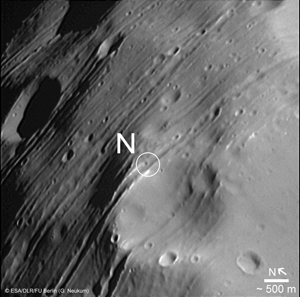 As
for the markings, nothing similar had been seen before, or since in the solar
system. To this day as with the voids, no solid explanation has been offered by
NASA. Strangely, we seem to know more about the depths of Titan’s oceans than
about the quite visible grooves of Phobos. Stranger still, we frequently read
and hear from NASA folks gushing about the possibilities of primitive life
within those oceans. Missing are scientists commenting about higher life forms
having possibly interacted with Phobos.
As
for the markings, nothing similar had been seen before, or since in the solar
system. To this day as with the voids, no solid explanation has been offered by
NASA. Strangely, we seem to know more about the depths of Titan’s oceans than
about the quite visible grooves of Phobos. Stranger still, we frequently read
and hear from NASA folks gushing about the possibilities of primitive life
within those oceans. Missing are scientists commenting about higher life forms
having possibly interacted with Phobos.
We might ponder why NASA has settled on the term of “grooves” for the markings when other more formal geological, descriptive terms would apply if they were natural formations. The answer is because the markings are precisely that, “grooves” cut into the surface by unknown objects. At some point NASA realized what caused them, and the markings were correctly and not innocently labeled grooves. In this seemingly innocent naming, NASA will never have to go back and reclassify them once they are recognized for what they are. That descriptive nomenclature will always correctly apply.
The Vikings recorded dozens of excellent images of the grooves. Some are very striking close-ups. One was taken from only 80 km away and shows a field of grooves resembling a plowed field. For decades now, its carefully cropped image, it has been the defining one presented to the public across the whole of the media. But the image shows only a small area of curious terrain.
What is revealed on the Viking CD set from NASA is an entirely different understanding of the grooves. Within the set, whole fields of striking grooves are apparent, hundreds, across varying angles covering major parts of the surface. Most grooves are oriented along the length of the body. Some fields meet other fields at various angles. Some overrun others. Some appear fresher that more weathered others. Some are deeper, wider and longer. The recent ESA images of Phobos give excellent examples of the grooves, and while their resolution is better than the three-decades old Viking images, they are no better in showing the truth of what has been denied us all of these years.
It has been claimed that intelligent actions on Phobos, strip mining, for example, is an explanation for the grooves. That would appear to make sense in view of how strip mining is done on Earth: Phobos and Deimos were brought to Mars for mining from the outer reaches of the asteroid belt where their D-type cluster, normally resides. And even if moved to Mars for an entirely different purpose, such as an artistic, technological whim, it still may have contained exotic resources worth mining.
Some of the incredible images returned from the Viking Orbiters give an exceptional perspective on the longer, more independent family of grooves. One vivid groove in particular provided the insight to suggest the answer to the entire mystery. Frankly, not much insight or intelligence was necessary. All that is required is for the conscious mind to acknowledge what the eyes reported regardless of what explanations have been planted by others.
The key image bringing this realization is frame no. F244A08 on volume 1014 of the Viking series of CDs from NASA. The image is a high-resolution picture of the underbelly of Phobos which highlights the most prominent groove. A spectacularly beautiful and vivid image of Phobos, it is a classic, full-bodied image. It is the most commonly found full-length image in publications and on the internet. It has not been bettered with subsequent images of that type from later probes. To the contrary, it has been replaced by those depicting less telling features.
I studied the picture for several minutes the first time I came across it on the Viking CD set. I had seen the image many times before, but never as sharp and clear as what filled the computer screen. There was a nagging familiarity to the image of this yet strange scene of this distance, little body.
I realized with a start that I was seeing a similarity to something more earthly. The picture looked exactly as if a large boulder had slid down the side of a mountain slope. The similarity was remarkable. Except in this case, the line of travel appeared horizontally along the length of Phobos rather than vertically, down a slope. Otherwise, the scene had no relationship to a mountain. In fact, on little Phobos, there would be no up or down, only minuscule gravity and certainly nothing to pull anything “down” the length of Phobos.
How could that same effect happen along the length on Phobos if it had so little differential in its physical environment? How could that condition possibly present itself under those circumstances? What were those assumed circumstances? What was its physical environment if not now, but at some earlier point in time? I mulled the situation over for a couple of days and finally the answer came to solve the entire riddle of Phobos, to justify UFOs and to recognize that we have ancient neighbors.
The creation of the grooves is best conveyed by understanding them as formed by large blocks of solid material having moved, slid, down the side of “Mount” Phobos. But we need to completely change that dynamic image to match the real events that made it so.
Imagine in your mind’s eye a picture of a boulder slipping and rolling down a mountainside leaving a…. Stop! Let’s reverse the dynamics. Instead, envision the mountain moving and the large boulder remaining relatively stationary! The result is the same. -- Find that not easy to adapt to Phobos? Then think of it in the following way.
Switch the mind’s eye to see a more earthly, silly scenario of what we can call a Phobos brand pickup truck setting at a stoplight with a layer of fine sand in the truck bed and a large rock setting atop that layer.
The truck is motionless. The light changes to green, and the driver accelerates away, unfortunately, too fast. The truck moves as one unit, of course, the sand pretty much moves along with the truck with some grains dribbling out the back. But the large rock has stronger and different geometric and physical forces acting on it. It tends to want to stay where it was, stationary. As the truck starts accelerating, the rock does start to move too, but not at the same rate as the truck. The rock uses its inherent stationary mass and the lubrication qualities of the sand to resist motion. It appears to slide down the length of the truck bed when in reality, the truck is moving out from under it. If the tailgate is down, the rock relocates itself to the ground, bounces and rolls a bit before becoming truly stationary while the truck zooms away.
We carry this mechanism of an accelerating body and its shifting load to the real world of Phobos. At some point in its history the body of Phobos was accelerated at a rate sufficient for loose boulders and rocks on its surface to slide in the regolith (loose surface material) down its length and some of them, due to the low gravity, continued to move off into space.
The acceptance of the activities which caused the markings on Phobos requires a clear but simple understanding of the forces of gravity and mass as they exist on that little body. There is hardly any relationship between how those forces operate on Earth versus on Phobos, even though the natural forces are the same. Actually, gravity is almost non-existent on Phobos. A 250 lb human on Earth would weight less than four ounces on Phobos. That is less than 1/1000th of Earth’s gravity. The escape velocity there is not more than a meager 30 miles per hour and half that at some points on the unevenly shaped body. Compare that with the 7 miles per second required for the escape velocity of anything from the surface of the Earth. On Phobos, you can throw a baseball into orbit.
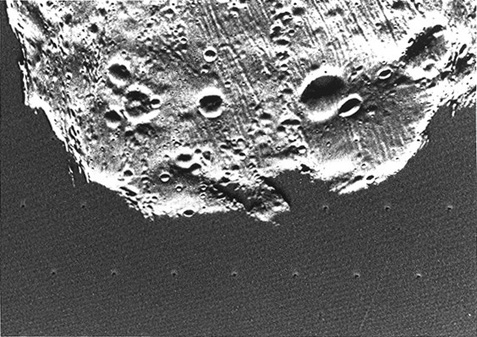 The
regolith on Phobos does not resemble earthly dirt. It is an ultra-fine dust.
Apollo astronauts found that Moon dust, a universal dust, was a stubborn problem
because it was extremely fine textured, similar to cement powder and crept into
everything. One astronaut called it "greasy." On Phobos with miniscule gravity,
it goes without saying that its regolith material would have a less dense
consistency and more of a lubrication quality far beyond loose sand and dirt we
are familiar with here.
The
regolith on Phobos does not resemble earthly dirt. It is an ultra-fine dust.
Apollo astronauts found that Moon dust, a universal dust, was a stubborn problem
because it was extremely fine textured, similar to cement powder and crept into
everything. One astronaut called it "greasy." On Phobos with miniscule gravity,
it goes without saying that its regolith material would have a less dense
consistency and more of a lubrication quality far beyond loose sand and dirt we
are familiar with here.
Combine the deep, loose regolith on Phobos with a house-sized boulder set within it, give the moon a quick shove and the boulder because of the resistance of its mass to motion becomes virtually a standing still bulldozer as everything else moves. In the almost none-existent field of gravity on Phobos, the results tend to mimic our truck and rock scenario, and grooves are formed.
In the layer of regolith in the truck, the groove left from the stone would be fairly uniform, straight out the back. On the surface of Phobos, the grooves would be somewhat curved and uneven in depth and width due inconsistencies of the surface upon which the house-sized objects moved as they used their mass to push their way to escape through the regolith. There are few if any remnants of these discrete rock bodies visible on Phobos because they have been sloughed off the surface when Phobos was repeatedly hit with velocity increases and decreases. Those that remain are more deeply anchored or otherwise hindered from moving.
On a body moving in the frictionless medium of space, the force required to stop a motion is equal to the force it took to get it moving to that velocity.
Graphically put, the stopping thrust must equal the starting thrust. Viking images plainly show both ends of the moon lost material off their ends. This illustrates two major opposite velocity changes were introduced upon the body probably via repeated accelerations and decelerations of velocity and positioning maneuvers.
We Earthlings must use a one-engine style of space propulsion because every ounce of that machine has to be lifted through the Earth’s gravity at a tremendous cost of propellant. The luxury of our having the option of two main systems is unthinkable due to such constraints. But we make do. We simply employ maneuvering thrusters to turn the craft around 180 degrees for retro-fire.
With a large object like Phobos, turning it 180 degrees for retrofire of a one-engine system would not be a simple task. Structural integrity, stability and maintaining course would become major concerns when applying a lateral force to a speeding mass that size. Unlike a manufactured spacecraft, its strengths and weaknesses could not be known with finite measure. And that method of maneuvering would require robust/long-duration side-thrusters (or angled main thrusters) to get the body turned for retrofire. Any turning of the body would be done slowly during the bulk of the transition. Some of the other field of grooves perpendicular to the longitudinal line of thrust for the main “engines” are suggestive that it did undergo some side thrusting, perhaps at the critical time of insertion into the Mars’ orbit.
The tell-tale grooves readily seen in the images running off both ends of Phobos are silent indications that the surface material fell off via the use of primary thrusters on both ends. First from one end during the Jupiter orbit-busting phrase, and then at the Crater Stickney end, during the deceleration/directional changes required to slow the body and place it into the tight orbit.
We know the maximum amount of velocity change required to shake the debris free from Phobos in one instant. That would be the escape velocity required for the little moon, which is about 30 miles per hour maximum. If the Martians had some super-colossal propulsion source capable attaining 30 mph very quickly for that large mass, then the debris would have been thrown off just as swiftly.
That possibility seems unlikely, and the evidence shows otherwise. If that was the case, we wouldn’t see the visible evidence of the long grooves, instead we would see only short ones where the boulders were jolted from deep pockets where they had lain for millions of years and in the next few seconds bounded off the surface. With the long grooves, however, we can determine that Phobos was not moved by any fast, magical means. And in fact, at a rate of acceleration/deceleration considerably under the 30 mph escape velocity. Rather, the debris moved along the surface in a comparatively gentle series of jostles until lost off the receding end.
A section in my main work from which this is taken discusses Project Orion. This was an unbelievable late 1950s hydrogen bomb-powered rocket concept.
As crazy as it sounds, the concept lived as an actual project for several years within which the famous Freeman Dyson was a devoted participant. It involved firing H-bombs at about half-second intervals to act against a concave blast-reaction shield/plate to lift a gigantic, 4000-ton space ship from Earth. This concept applied to Phobos can be visualized as craters being the reaction plates. The crater Stickney and its interior smaller member is a perfect example of what we could expect to see on Phobos. Of course, this concept may not relate to the method the Martians actually used, but the adoption of the Orion process and evidence of what can be called “blast craters” gives an understandable means of locomotion within our limited human reasoning and envisioning powers.
There is an intriguing, possible link between the long-gone Project Orion, asteroids, and Phobos. In the last chapter of the book by that name authored by George Dyson, the son, he innocently sums up the Orion affair as he quotes his father as telling him in 1999: “NASA officials have booked a conference room at the Institute for Advanced Study in Princeton for Monday morning next week and are flying up from Huntsville with twelve scientists who want to talk about Orion. Do they know something we don’t?” After the meeting, NASA requested to buy 1759 pages of old Orion documents that the young Dyson, had collected in his research efforts for writing the book. Some months later he received a draft report entitled "External Pulsed Plasma Propulsion and Its Potential for the New Future." The report said in part. "EPPP provides a technology that would allow us to seriously consider missions to the outer planets. It would also enable dramatically shorter trips times to Mars and other nearer-term destinations. The other and perhaps most compelling application for EPPP is its use in asteroid or comet defense. There is a low, but not negligible probability of a collision with objects of sufficient size to cause catastrophic damage or an extinction-scale event. Good risk management would dictate that some effort be placed on devising countermeasures, if possible."
This passage in the report reveals that they see the potentiality for redirecting asteroids away from close encounters with the Earth/Moon system via Orion-type methods and as they first mentioned, as actual vehicles for interplanetary space flight. Could that professed interest, while soundly legitimate, can also be a cover for a slightly different reason for the interest NASA had in the Orion? Having recognized that Phobos was moved, they would have a strong interest in how that monumental mission was accomplished.
The proposed firing frequency for the Project Orion rocket to achieve escape velocity from Earth at half-second intervals was to prevent it from falling back. The firing rate of a possible Phobos primitive bomb engine would not be a factor. No specific escape velocity was necessary to nudge the asteroid out of a solar orbit 2.5 AU from Mars. A leisurely few jolts, perhaps infrequent, would suffice when the asteroid was in the proper position for the transition. The fall to the Mars’ area of rotation would be gravitationally assisted by the Sun’s influence, a free tug by gravity toward the target, but too much so. The additional velocity of falling inward would require a prolonged over-cancelling (slowing) of those increases during much of the inward journey.
The entire process from orbiting near Jupiter to orbiting Mars may have consumed about a year. To be sure, there would have been a precise coordination to the efforts of position and velocity during the journey, but few places in the transition would be as demanding as when the 16x13x11-mile body was brought into the vicinity of Mars’ gravity.
The Phobos-to-be asteroid probably was set in motion before the onboard habitat construction was started. This plan would have allowed for stronger, jarring blasts to be used with the only consideration being the structural integrity of the body. Concurrently, these explosions would have been an excellent opportunity to perform dynamic tests of the body’s integrity. If it failed by some unforeseen flaw, it could be discarded in route and the search started again for another candidate. At the end of the journey, the stresses of maneuvering the body into a Mars’ orbit would have been a further test of its durability.
However, by doing the interior “renovation” of the asteroid during the transition, the removed material would have been merely dumped overboard with enough of a push to escape the body’s low gravity. In that fashion, they prevented any problem of disposing of the material once in close orbit around Mars.
The Martian’s could take their time setting up each shot. A precise, blast-every-half-second delivery system absolutely dictated for an Orion ship would have been totally unnecessary. The most simplistic procedures possible would have sufficed. A little ship could drop down into the crater shield, position the bomb at leisure and then back off around the crater’s edge to fire it remotely.
The grooves present us with a full record of the motions, from start to end, that the body went through as it was guided to Mars. Many of the grooves on Phobos lead directly to the tips where they end, of course, having slipped off into space, off the tailgate of Phobos so to speak. Such traces also tell us that the relative escape velocity of the debris (relative to the acceleration/deceleration of the main body) was not reached by rapid, successive firings. If so, grooves would end at some point before reaching the end of the body as escape velocity was reached. They would show progressively shallower as the debris approached their relative escape velocities and would end altogether when that velocity was obtained and/or they bounced and skimmed away from the surface before reaching the turned-down end.
The sage of the moons of Mars could stop at this point, but it cannot. This is but the beginning. There is a larger scenario to be contemplated. Deimos was probably the first body brought down as a test of the Martian’s abilities. It was placed at a relatively safe distance of three Mars’ diameters (7767 miles) away from the surface. The far, far more incredibility difficult but precise placement of Phobos at a distance of only 3715 miles above the surface is excellent evidence also that Deimos was carefully placed, and we can say that with confidence.
Deimos probably and originally was set in a synchronize orbit that has slipped over the eons as it slowly drifts away from Mars. (Phobos is slowly sinking toward Mars and Deimos is moving away.) We can expect that astrophysicists can trace back the approximate date when Deimos was installed in such an orbit based on that understanding. Undoubtedly, that would have been a very long time ago, perhaps before the time of humans.
The bringing of Phobos to a Mars’ orbit was a dangerous undertaking. Given the condition of Mars today, perhaps Phobos was hauled in to be nothing more than an in-kind monument to a virtually dead Mars caused by an earlier attempt that went terribly wrong, fell to Mars and destroyed their civilization and the planetary environment. The gigantic gash of Valles Marineris may be evidence of that catastrophe.
Mars and UFOs: The great varieties of UFOs we witness makes it unlikely that all are from one place. The numbers and types of ships, and various behaviors are indicative that a huge if uncountable number of other visitors are coming here in addition to the few, if any, remaining Martians. Perhaps they are old friends dropping by the old neighborhood to check out the new people and visit with the old folk.
There you have it. Any and all of my words here may be inaccurate and even false by some standards. I claim to be no expert. However, they are true to the best of my abilities or I would not have put them down. I understand this is a very complex matter that goes far beyond my words here, damning conventional dogma in astronomy and how our governments have reacted to their own discoveries of outside forces stronger by far than they. But Phobos is the key. With these words, I believe the key is turning in the lock. Is humanity and their governments up to the task of opening that door and stepping out into the Universe? Do we have a choice?
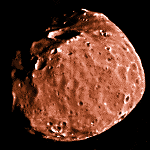 Regular
readers to this site may have read in the past our articles on Phobos,
which is one of the small moons that circle around Mars. As we have speculated
before, this 'moon' seems to be very odd, and has
always been considered a rather mysterious object, as has its smaller twin,
Deimos. Recent events seem to have strengthened our beliefs as news recently
reached us that both Moons have mysteriously disappeared... But first,
lets look at the history of these moons and tell you of some strange events
that have been related to them in the past. Joseph Shklovskii noted member
of the Soviet Academy of science and co-writer with Dr Carl Sagan of
'Intelligent life in the universe', once calculated from the estimated
density of the Martian atmosphere and the peculiar "acceleration" of
Phobos, that the satellite must be hollow.
Regular
readers to this site may have read in the past our articles on Phobos,
which is one of the small moons that circle around Mars. As we have speculated
before, this 'moon' seems to be very odd, and has
always been considered a rather mysterious object, as has its smaller twin,
Deimos. Recent events seem to have strengthened our beliefs as news recently
reached us that both Moons have mysteriously disappeared... But first,
lets look at the history of these moons and tell you of some strange events
that have been related to them in the past. Joseph Shklovskii noted member
of the Soviet Academy of science and co-writer with Dr Carl Sagan of
'Intelligent life in the universe', once calculated from the estimated
density of the Martian atmosphere and the peculiar "acceleration" of
Phobos, that the satellite must be hollow.
Could Phobos be a hollowed-out space station of huge proportions? In July 1988, the Russians launched two unmanned satellite probes - Phobos 1 and Phobos 2 - in the direction of Mars, with the primary intention of investigating the planet's mysterious moon, Phobos.
Phobos 1 was unfortunately lost en route two months later, reportedly because of a radio command error. Phobos 2 was also ultimately lost in the most intriguing circumstances, but not before it had beamed back certain images and information from the planet Mars itself.
Phobos 2 arrived safely at Mars in January 1989 and entered into an orbit around Mars as the first step at its destination towards its ultimate goal: to transfer to an orbit that would make it fly almost in tandem with the Martian moonlet called Phobos (hence the spacecrafts name) and explore the moonlet with highly sophisticated equipment that included two packages of instruments to be placed on the moonlet's surface.
All went well until Phobos 2 aligned itself with Phobos, the Martian moonlet. Then, on 28th March, the Soviet mission control center acknowledged sudden communication "problems" with the spacecraft; and Tass, the official Soviet news agency, reported that "Phobos 2 had failed to communicate with Earth as scheduled after completing an operation yesterday around the Martian moon Phobos. Scientists at mission control have been unable to establish stable radio contact."
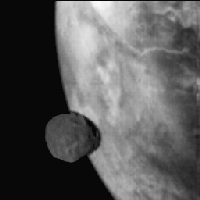 What
had caused the Phobos 2 spacecraft to be lost?
What
had caused the Phobos 2 spacecraft to be lost?
According to Boris Bolitsky, science correspondent for Radio Moscow, just before radio contact was lost with Phobos 2, several unusual images were radioed back to Earth, described by the Russian as "Quite remarkable features". A report taken from New Scientist of 8 April 1989, described the following: "The features are either on the Martian surface or in the lower atmosphere. The features are between 20 and 25 kilometers wide and do not resemble any known geological formation. They are spindle - shaped and proving to be intriguing and puzzling."
An unusual photo of a thin shadow across mars was shown on the Russian television segment. Seen on the surface of Mars was a clearly defined dark shape that could indeed be described, as it was in he initial dispatch from Moscow, as a "thin elipse" (this photo is a still from the Soviet television clip). It was certainly different from the shadow of Phobos recorded eighteen years earlier by Mariner 9. The latter cast a shadow that was a rounded ellipse and fuzzy at the edges, as would be cast by the uneven surface of the moonlet.
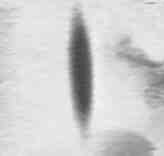 The 'anomaly' seen in the Phobos 2 transmission was a thin
ellipse with very sharp rather than rounded points (the shape is known
in the diamond trade as a "marquise") and the edges, rather than
being fuzzy, stood out sharply against a kind of halo on the Martian surface.
The 'anomaly' seen in the Phobos 2 transmission was a thin
ellipse with very sharp rather than rounded points (the shape is known
in the diamond trade as a "marquise") and the edges, rather than
being fuzzy, stood out sharply against a kind of halo on the Martian surface.
Dr. Becklake described it as "something that is between the spacecraft and Mars, because we can see the Martian surface below it," and stressed that the object was seen by both the optical and the infrared (heat seeking) camera.
All these reasons explain why the Soviets have not suggested that the dark, "thin ellipse" might have been a shadow of the moonlet. While the image was held on the screen, Dr. Becklake explained that it was taken as the spacecraft was aligning itself with Phobos (the moonlet). "As the last picture was halfway through," he said, "they [Soviets] saw something that should not be there."
So what was it that collided or crashed into Phobos 2? Was the space probe shot out of space for "seeing too much"? What does the last secret frame show? Well... Cosmic Conspiracies have managed to track down this ellusive last picture (see below). In his careful words to 'Aviation Week and Space Technology', the chairman of the Soviet equivalent of NASA, referred to the last frame, saying, "One image appears to include an odd-shaped object between the spacecraft and Mars."
This "highly secret" photo was later given to the Western press by Colonel Dr. Marina Popovich, a Russian astronaut and pilot who has long been interested in UFO's. At a UFO conference in 1991, Popovich gave to certain investigators some interesting information that she "smuggled" out of the now ex-Soviet Union. Part of the information was what has been called "the first ever leaked accounts of an alien mother ship in the solar system".
The
very last picture taken by Phobos 2
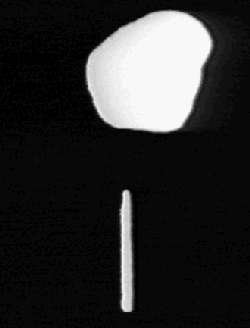
The cigar shaped craft in the penultimate frame taken by Phobos 2 is apparently the object casting the oblong shadow on the surface of Mars in the earlier photo.
Australian science writer Brian Crowley says that because of the convex cats eye shadow - which, because the overhead solar inclination prevented shadow - casting by Martian surface features, implies a shadow thrown on the surface from something in orbit - beyond the orbit of Phobos 2 itself.
The shadow - spindle - or cigar shape - is inconsistent with any possible shadow cast by the moon Phobos, which is an irregular potato shape. One needs little imagination to postulate a giant, hovering cigar- shaped mother craft similar to those documented down the years by UFO investigators.
Have Phobos and Diemos Disappeared?
We know from Malin Space Science Systems that the Mars Orbital Camera on the Mars Global Surveyor observed the shadow of Phobos on the surface of Mars on August 26, 1999, September 1, 1999, September 8, 1999, and September 25, 1999 and November 1, 1999. Due to the changing geometry of the MGS orbit relative to that of Phobos, the shadow is actually seen in MOC global map images about a dozen times a month. That being the case, would it really be so much trouble to show some Phobos shadows after June 4, 2000? With all the assets presently at its command, NASA could resolve the issue of Phobos in a heartbeat with a current shadow image without having to change any of its mission plans.
With the latest speculation that Phobos and Deimos have vanished, it is critical that someone comes forward with new observation data. With the recent global dust storm on Mars, and the increasing sightings of rare meteor events here on Earth, the sense of urgency for closure is being reinforced. Above all others, NASA has the assets to resolve this issue quickly and decisively. Yet, it hides in the shadows.
Looking at the history of NASA's busted theories and the virtual Mars imagery monopoly they’ve granted to Malin Space Science Systems (MSSS), it becomes apparent why they have their heads in the sand – politics and funding. If future events prove this to be so, then they’ve betrayed American taxpayers who have generously funded their programs, and who rightfully depend on all agencies of their government to protect them from harm.
As most readers will be aware, YOWUSA has been trying to solve the mystery surrounding the fate of comet 76P and its effects (if any) it had on the moons of Mars for some time now. So far, the prevailing theory has been that 76P had either significantly disturbed the orbit of Phobos, or collided with it. Therefore, our efforts have focused on obtaining either a good quality image of Phobos from a reliable source, or data indicating that 76P was indeed where it should have been after passing Mars. With two avenues to pursue, one could not be blamed for thinking this was going to be easy.
However, earlier this year NASA set the scene for a trend that would continue until this day.
76P Update -- NASA Refuses To Substantiate Hubble Sighting
Mars Global Super Storm
The MSSS images show a very red, dusty and warmer Mars that has resulted from this storm. However, the true severity of the storm is hard to tell because it appears to be off the charts. The storm actually started after the last known picture of Phobos was taken, and could perhaps suggest that the actual storm could have been started by Phobos hitting the side of Mars.
A further reason for that concern is that NASA and their educated associates do not have a clear idea as to what caused this remarkable storm. But one thing is for certain; they are not particulary interested in understanding why. Or, they are truly interested and want to play the story down. Nonetheless, the possibility of an impact event being the cause of the present super storm on Mars cannot, and should not be ignored. However, it is also possible that a large, but ordinary meteorite or several smaller ones caused the storm.
The theory favored by NASA on the other hand, blames the current super storm on Mars on planetary events, while ignoring any possiblity of an impact event.
Dr. Tom Van Flandren, former lead astronomer at the Naval Observatory and NASA contractor, stated for the first time publicly he believes the cause of last months huge dust storm which surrounded the whole planet of Mars, "was most likely caused by an asteroid hit." Now a group of astronomers are coming together to discuss this very real scenario. In several of the Thermal Emission Spectrometer (TES) images, star patterns can be seen that could indicate large sudden impact events. These stars appear in the same region where the storm erupted.
The star patterns show a very cold central interior that progressively gets hotter and dustier in the outer region. This pattern is what you could expect after an impact throws up the heated dust and rock into the atmosphere, leaving a cold interior that eventually warms again as the dust settles down. Given that at this stage NASA still seems to be puzzled, any theory such as the one proposed by Russia and Dr. Van Flandern is acceptable and should be up for consideration. However, the chances are slim that this theory will be seriously considered by NASA and their associates
Below is a staggering list of NASA projects that MSSS has been involved with since its inception in 1990.
Current Projects
Mars Global Surveyor MOC
2001 Mars Odyssey Orbiter Visible Imager for THEMIS
Mars Global Surveyor Thermal Emission Spectrometer Team
Mars Surveyor Athena Rover Team
Mars Data Analysis
Program
Past Projects
Mars Observer MOC
Mars Climate Orbiter MARCI
Mars Polar Lander MARDI
Mars Surveyor 2001 Lander Descent Imager
Mars Pathfinder
Science Team
Malin also likes
to flaunt his monopolistic over Mars imagery every now and then (“It’s
good to be the King.”)
If Malin does have a monopoly Mars imagery, is it because he is the only skilled person in the world? Or, is he simply a competent scientist who sold out to the national security folks; who are the tail that wags NASA’s dog?
CHAIN CRATERS OF PHOBOS
"Viking has discovered another mystery in the most unexpected place - one of the two small Martian moons. Mariner 9's mapping of Phobos (12x14x17 miles or 20x23x28 kilometers) and Deimos (6x7x10 miles, or 10x12x16 kilometers) showed many craters, and left most investigators with the impression that they were merely rocky chunks that bore the scars of meteorite impacts. There was a puzzling feature on Phobos that a few analysts noticed but, without better data, could say little about.
At the limit of resolution were a few small crater pits that seemed to align in one or two chains. This was unusual, because crater chains on the moon were traditionally explained as volcanic pits - small eruption sites string along fracture lines. Yet Phobos apparently is too small to generate heat and conventional volcanic activity.
"Vikings high resolution photos have revealed that the crater chains are real and part of an extensive system of parallel grooves, a few hundred yards wide (shown in Viking orbiter photo number 39B84). There may be a tendency for the grooves to lie parallel to the direction of the satellites orbital motion, although there appears to be several swarms with somewhat different orientations. Scientists are at a loss to explain them. Theories being discussed include: grooves left by much smaller satellite debris also orbiting Mars (though the grooves seem to follow contours of Phobos' surface to closely for this to be tenable); fractures radiating from an impact crater not yet recognized (perhaps on the side of Phobos still poorly photographed); or fractures created in the body of the Martian satellite when it was part of a hypothetical larger body and that it spawned both Martian moons, perhaps during a catastrophic impact."
In the latest effort to photograph Mars and its moons, the NASA 'Mars Observer' was launched from Cape Canaveral Air Force Base in Florida in late 1992, on a 337 day voyage to Mars. The Mars Observer initially was expected to arrive at Mars by 19 August 1993, and enter a long, elliptical orbit over the poles. In mid November 1993 it was to begin its two year mapping of the surface of Mars. Then suddenly, on 22nd August 1993, it was announced that NASA had lost contact with the spacecraft.
Americans and the world mourned the loss of a valuable scientific tool for understanding Mars. Taxpayers wondered if there was a better way to spend their money than on expensive space probes that didn't work. A dark shield was going up on new information about Mars to the public at large...
According to retired Soviet Air Force Colonel Marina Popovich, Phobos, one of the two Martian moons, is an artificial structure. In a meeting with CSETI's International Director, Dr. Steven Greer, she told him that her sources also advised that it is hollow.
Interestingly, the same story was told to contactee Paul Villa Jr. by an ET that he had an encounter with in Long Beach, Ca in 1953. (See "Alien Base", by Timothy Good, P. 241)
INFRARED PHOTOS OF AN UNDERGROUND CITY
Pressed by their international participants in the Phobos missions to provide more definitive data, the Soviet authorities released the taped television transmission Phobos 2 sent in its last moments - except for the last frames, taken just seconds before the spacecraft fell silent. The television clip was shown by some TV stations in Europe and Canada as part of weekly "diary" programs, as a curiosity and not as a hot news item.
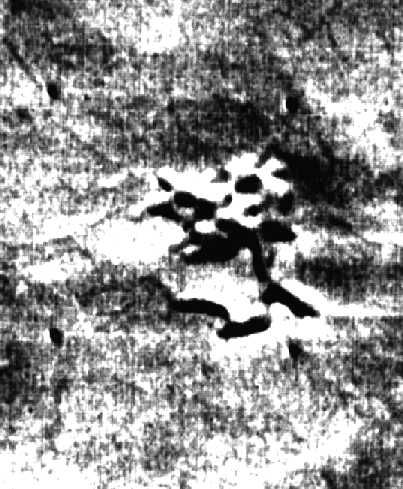 The
television sequence thus released focused on two anomalies. The first was
a network of straight lines in the area of the Martian equator; some of
the lines were short, some longer, some thin, some wide enough to look
like rectangular shapes "embossed" in the Martian surface. Arranged in
rows parallel to each other, the pattern covered an area of some six hundred
square kilometers (more than two hundred thirty square miles). The "anomaly"
appeared to be far from a natural phenomenon.
The
television sequence thus released focused on two anomalies. The first was
a network of straight lines in the area of the Martian equator; some of
the lines were short, some longer, some thin, some wide enough to look
like rectangular shapes "embossed" in the Martian surface. Arranged in
rows parallel to each other, the pattern covered an area of some six hundred
square kilometers (more than two hundred thirty square miles). The "anomaly"
appeared to be far from a natural phenomenon.
The television clip was accompanied by a live comment by Dr. John Becklake of England's Science Museum. He described the phenomenon as very puzzling, because the pattern seen on the surface of Mars was photographed not with the spacecraft's optical camera but with its infrared camera - a camera that takes pictures of objects using the heat they radiate, and not by the play of light and shadow on them. In other words, the pattern of parallel lines and rectangles covering an area of almost two hundred fifty square miles was a source of heat radiation. It is highly unlikely that a natural source of heat radiation (a geyser or a concentration of radioactive minerals under the surface, for example) would create such a perfect geometric pattern. When viewed over and over again, the pattern definitely looks artificial; but what it was, the scientist said, "I certainly don't know." (Cosmic Conspiracies have written to Dr. Becklake in the hope that we can track down this picture).
Since no coordinates for the precise location of this "anomalous feature" have been released publicly, it is impossible to judge its relationship to another puzzling feature on the surface of Mars that can be seen in Mariner 9 frame 4209-75 (pictured left). It is also located in the equatorial area (at longitude 186.4) and has been described as "unusual indentations with radial arms protruding from a central hub" caused (according to NASA scientists) by the melting and collapse of permafrost layers. The design of the features, bringing to mind the structure of a modern airport with a circular hub from which the long structures housing the airplane gates radiate, can be better visualized when the photograph is reversed.
We have managed to track down the final picture taken by Phobos 2 before it was "shot out of orbit" (see above). One report indicated that it was presented at a closed meeting with US and British officials.
In the 19th October, 1989 issue of 'Nature', Soviet scientists published a series of technical reports on the experiments Phobos 2 did manage to conduct: of the thirty seven pages, a mere paragraph deal with the spacecrafts loss.
The report confirms that the spacecraft was spinning, either because of a computer malfunction or because Phobos 2 was "impacted" by an unknown object. And so we see that it is not only NASA that is apparently involved in suppressing photographs and knowledge of other planets, but the Russian space program as well.
WEIRD ANOMALY PHOTOGRAPHED ON ROCK
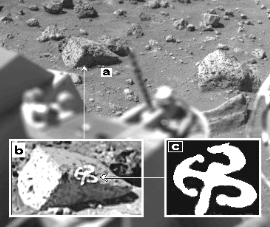
We
have managed to obtain this photo taken by the pathfinder of a very weird
symbol on a rock... What could it be?
Checkout
our Mars Anomalies Section. You wont believe your eyes as we show you
pictures
of glass tunnels and evidence of an underground city!